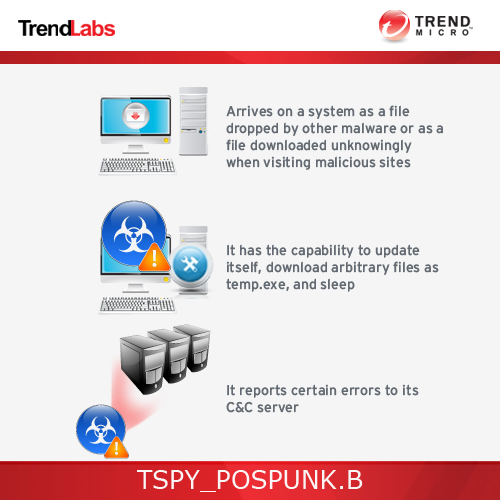TSPY_POSPUNK.B
Infostealer.Pospunk (Symantec); Trojan.Win32.S.PunkeyPOS.370208[h] (ViRobot); Win32/Spy.POSCardStealer.AN (ESET-NOD32); Punkey-FCCI!BE46B05244DB (McAfee)
Windows


Threat Type: Spyware
Destructiveness: No
Encrypted: No
In the wild: Yes
OVERVIEW
Downloaded from the Internet
This malware component is related to the Punkey point-of-sale (PoS) malware, which was uncovered in April 2015.
To get a one-glance comprehensive view of the behavior of this Spyware, refer to the Threat Diagram shown below.

This spyware arrives on a system as a file dropped by other malware or as a file downloaded unknowingly by users when visiting malicious sites.
It logs a user's keystrokes to steal information.
It deletes itself after execution.
TECHNICAL DETAILS
370,208 bytes
EXE
Yes
09 Jun 2015
Connects to URLs/IPs
Arrival Details
This spyware arrives on a system as a file dropped by other malware or as a file downloaded unknowingly by users when visiting malicious sites.
Installation
This spyware drops the following copies of itself into the affected system and executes them:
- %AppDataLocal%\jusched\jusched.exe
(Note: %AppDataLocal% is the Application Data folder found in Local Settings, where it is usually C:\Documents and Settings\{user name}\Local Settings\Application Data on Windows 2000, Windows Server 2003, and Windows XP (32- and 64-bit); C:\Users\{user name}\AppData\Local on Windows Vista (32- and 64-bit), Windows 7 (32- and 64-bit), Windows 8 (32- and 64-bit), Windows 8.1 (32- and 64-bit), Windows Server 2008, and Windows Server 2012.)
It drops the following component file(s):
- %AppDataLocal%\jusched\cookie - contains the UID
- %AppDataLocal%\jusched\Dllx64.dll - detected as TSPY_POSPUNK.B which is a component used for keylogging routine
(Note: %AppDataLocal% is the Application Data folder found in Local Settings, where it is usually C:\Documents and Settings\{user name}\Local Settings\Application Data on Windows 2000, Windows Server 2003, and Windows XP (32- and 64-bit); C:\Users\{user name}\AppData\Local on Windows Vista (32- and 64-bit), Windows 7 (32- and 64-bit), Windows 8 (32- and 64-bit), Windows 8.1 (32- and 64-bit), Windows Server 2008, and Windows Server 2012.)
It injects codes into the following process(es):
- explorer.exe
Autostart Technique
This spyware adds the following registry entries to enable its automatic execution at every system startup:
HKEY_CURRENT_USER\Software\Microsoft\
Windows\CurrentVersion\Run
jusched = "%AppDataLocal%\jusched\jusched.exe -s"
Information Theft
This spyware accepts the following parameters:
- action = {getuid, sendinfo, getupdate, key, unkey}
- key= {RUN, SCANNING, or UPDATE}
- version= {malware version}
- bit= {32 or 64}
- unkey= {stolen information}
It logs a user's keystrokes to steal information.
Other Details
Based on analysis of the codes, it has the following capabilities:
- Update itself
- Download arbitrary file as temp.exe
- sleep
It deletes itself after execution.
NOTES:
It requests for the UID from the server. It then creates a cookie file once it receives the UID from the server.
It sends its GET or POST request to the following URLs:
- http://{BLOCKED}x.tqurl.net/21kjn2bkhjv/{string}
- http://{BLOCKED}6.31.93.208/21kjn2bkhjv/{string}
- http://{BLOCKED}1.72.36.109/21kjn2bkhjv/{string}
- http://{BLOCKED}8.32.9.105/21kjn2bkhjv/{string}
- http://{BLOCKED}2.3.201.32/21kjn2bkhjv/{string}
It scans the memory of all running processes except for the following:
It may report the following errors to its C&C server:
SOLUTION
9.750
11.720.04
09 Jun 2015
11.721.00
10 Jun 2015
Step 1
Before doing any scans, Windows XP, Windows Vista, and Windows 7 users must disable System Restore to allow full scanning of their computers.
Step 2
Restart in Safe Mode
Step 3
Note that not all files, folders, and registry keys and entries are installed on your computer during this malware's/spyware's/grayware's execution. This may be due to incomplete installation or other operating system conditions. If you do not find the same files/folders/registry information, please proceed to the next step.
Step 4
Delete this registry value
Important: Editing the Windows Registry incorrectly can lead to irreversible system malfunction. Please do this step only if you know how or you can ask assistance from your system administrator. Else, check this Microsoft article first before modifying your computer's registry.
- In HKEY_CURRENT_USER\Software\Microsoft\Windows\CurrentVersion\Run
- jusched = "%AppDataLocal%\jusched\jusched.exe -s"
- jusched = "%AppDataLocal%\jusched\jusched.exe -s"
Step 5
Search and delete these files
- %AppDataLocal%\jusched\Dllx64.dll
- %AppDataLocal%\jusched\cookie
- %AppDataLocal%\jusched\temp.exe
Step 6
Restart in normal mode and scan your computer with your Trend Micro product for files detected as TSPY_POSPUNK.B. If the detected files have already been cleaned, deleted, or quarantined by your Trend Micro product, no further step is required. You may opt to simply delete the quarantined files. Please check this Knowledge Base page for more information.
Did this description help? Tell us how we did.

